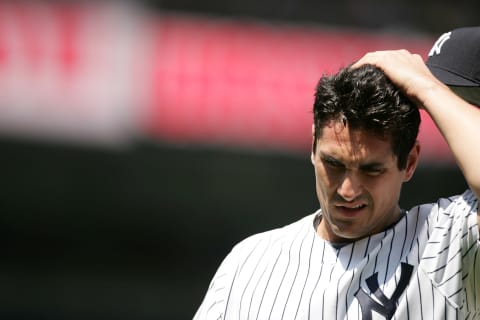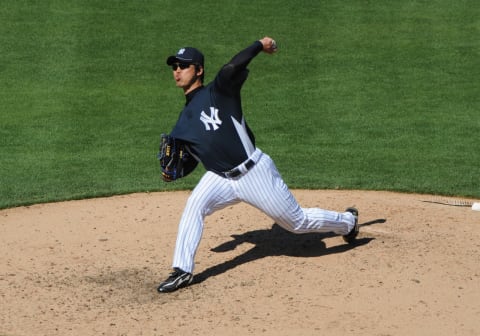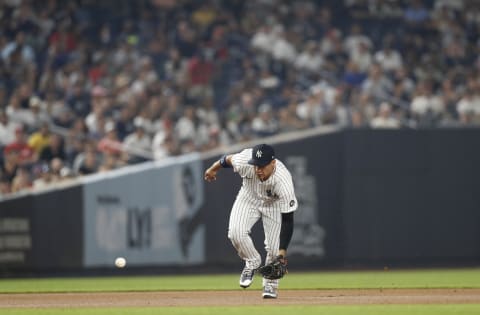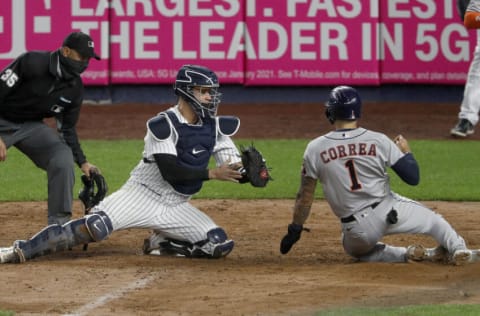4 players the Yankees waited far too long to pull the plug on


For almost two decades, the Yankees have shown an occasional tendency to wait too long to address situations with underachieving players. Whether they were homegrown products or free-agent signings, New York, as we know, likes to see its decisions through.
For validation? To maintain the status quo? To avoid instilling a hasty thought process? Who knows, but the Yankees typically wait it out and it typically frustrates the fans.
We have some very recent examples, as well as others from previous decades that might ring a bell. We apologize in advance for opening up any old wounds. Not our intention.
But there’s no question the Yanks made a mistake by acquiring players who did not pan out or permitting players to occupy a particular position on the field for far too long.
4. Carl Pavano (2005-08)
Following the disappointing 2004 season, the Bronx Bombers wanted to significantly improve their starting rotation. As a result, they signed Carl Pavano to a four-year, $39.95 million contract. They expected him to be their No. 2 starter behind Mike Mussina.
The righty won 18 games and earned a career-best 3.00 ERA for the Florida Marlins in 2004. Before then, however, he was only 39-50 with a 4.59 ERA across five years with the Marlins and Montreal Expos.
Pavano wasted no time showing the Yanks that his acquisition was a blunder. Pavano was put on the injury list with shoulder trouble in June 2005 and finished 4-6 with a 4.77 ERA in 17 starts. Then he bruised his behind (nope, we are not joking!) in spring training the following year. He also was involved in a car accident and missed the entire 2006 season.
Still, he was selected as the Opening Day starter in 2007. After only two starts, he was forced to undergo Tommy John surgery. He ended his Yankee tenure with a 5.77 ERA in seven starts in 2008. Altogether, he made only 26 starts in his four seasons as a man in pinstripes (9-8 with a 5.00 ERA).
The Yanks took a significant risk signing him, and they failed to cut bait during his stint when it was clear this was not going to work out.
Pavano is an example of why MLB teams should never spend a large amount of money on someone who outperformed their overall body of work in a contract year.

3. Kei Igawa (2007-11)
Following the conclusion of the 2006 season, the Boston Red Sox caught the baseball world’s attention by paying over $100 million (about half of the price was for negotiating rights) to sign highly-regarded Japanese star pitcher Daisuke Matsuzaka.
Not to be outdone, George Steinbrenner made his own move in the new Japanese market by signing Kei Igawa. After posting the winning bid of $26 million, the Yanks signed the lefty to a five-year, $20 million deal. But entering the Japanese market was an experiment and a risk for the organization.
Unfortunately, Igawa flopped in New York. He experienced control problems and went back and forth between the Yanks and Scranton Wilkes-Barre RailRiders in 2007. Igawa was 2-3 with a bloated 6.25 ERA (in 14 games and 12 starts) for the Bombers that year. In 2008 he pitched only two games and was impossible to trade.
Igawa spent the remainder of his contract being paid to pitch in the minors. After dropping a total of $46 million, the contract came to an end in 2011. He pitched in just 16 games and logged a 6.66 ERA and a 1.76 WHIP. It’s no consolation that Igawa is the all-time wins leader in Scranton/WBR’s history.
We’re just not sure why the Yankees saw this contract all the way through.

2. Gary Sanchez (2015-Present)
Gary Sanchez had a great deal of potential as a young catcher. However, he never performed up to his full athletic ability.
After playing only a couple of games in 2015, Sanchez busted out of the gate in 2016. Despite playing in only 53 games that year, he came in second in voting for the Rookie of the Year and slugged 20 homers.
Sanchez built on his debut in 2016 with a solid performance in 2017. However, he regressed substantially in 2018, had a rollercoaster 2019, and backslid massively again in 2020. Given this varied pattern (and the fact that 2020 was a shortened season), he was expected to have a great 2021 season.
Unfortunately, that was not the case. This past year the Kraken hit .204/.307/.423 with 23 home runs and a 99 wRC+. Further, he finished 17th among catchers in FanGraphs WAR with 1.5.
And Sanchez’s fielding has left plenty to be desired. FanGraphs assigned him a slightly positive Defensive Fielding and Positional Adjustment score of 3.5, which ranked him 21st among the 30 backstops to have 300 or more plate appearances. Disappointingly, he was in the 17th percentile in Framing, per Statcast and Baseball Prospectus measures.
Despite his raw talent, his overall performance statistics depict a below-average catcher on both offense and defense. Equally worrisome, at least two established starting pitchers this year (Gerrit Cole and Corey Kluber) did not want him to catch for them when it was their turn on the mound.
What do they know that GM Brian Cashman and manager Aaron Boone don’t?
The Bombers should have ended the Sanchez experiment following the 2020 season but didn’t. They could’ve traded him after 2019 when the warning signs popped up again. They didn’t.
They already had enough data to indicate that he would never live up to expectations. Excuses and rationalizations for his inferior play, often voiced by Boone (Sanchez’s Panglossian), only exacerbated the situation because there was no accountability. The club waited too long to address the team’s deficiency behind the plate, and now they’re likely stuck with him and his bloated salary for 2022.

1. Gleyber Torres (2018-Present)
After the 2019 season ended, the Yanks decided not to re-sign shortstop Didi Gregorius. As a free agent and solid ballplayer, the team would have had to pay a significant salary to retain him.
Rather than do this, the club decided to switch Gleyber Torres from second base to shortstop to save money. Also, as a young stud, he appeared to have unlimited potential and could eventually become an even better player than Gregorius.
Torres’ early success at the plate was not matched by his performance in the field. However, Cashman and Boone felt that Torres would have enough time to improve his defense as he developed as a young player. They apparently believed that his fielding and throwing would catch up with his excellent hitting over time. This made sense then.
In 40 games during the shortened pandemic 2020 season, he made nine errors as the team’s new shortstop. His fielding and throwing still suffered during spring training in 2021.
During the 2021 season, he played 108 games at shortstop and committed a dismal 18 errors for a .952 fielding percentage. This was substantially below the league’s average of .974 at the position.
The Bombers lost a number of important games due to his poor play at short. The fact that he regressed as a hitter in 2021 made matters worse.
Boone waited until the very end of the 2021 season to finally terminate the Torres shortstop experiment and switch him back to second base. The change worked. In 169.1 innings, he made only one error, and his hitting improved at the same time. His effective play at second and better hitting probably assured him a place on the team for the 2022 season.
Still, the Yankees waited too long to move Torres from shortstop to second base. This experiment cost the club home-field advantage for the Wild Card game during this year’s playoffs. There’s just no refuting that.
Yankee fans can probably point to additional instances where the Bombers took too long to admit that an experiment was not working. While MLB teams should exhibit a reasonable amount of patience with new players as well as those who are changing positions, they also must know when ample time has been given for things to work out.
Hopefully, Boone has learned his lesson with Sanchez and Torres as he embarks on his next stint with the Yankees.
